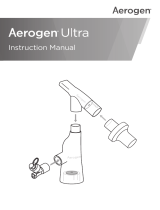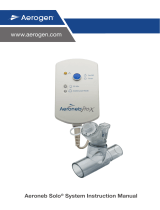
18 Aerogen®
7. Insert the syringe filled with medication into the syringe infusion pump
(pump not shown in Figure 5).
8. Turn on the 6 Hour Mode option on the Aerogen USB Controller and
turn on the infusion pump (refer to pump manual or manufacturer for
guidance).
9. Observe nebuliser for correct operation. During continuous
nebulisation, the nebuliser is on continuously and the medication is
nebulised on a drop by drop basis. Nebulisation should be visible with
regular intermittent pauses. Medication level in the nebuliser reservoir
should not rise during use.
10. To stop the nebuliser at any time, press the On/Off power button. The
indicator turns off to indicate that nebulisation has stopped.
Note: Aerogen’s recommended input rate of medication into the Aerogen
Solo nebuliser during continuous nebulisation is up to a maximum of 12
mL per hour. The upper limit of 12 mL per hour is based on Aerogen’s
specification for the minimum nebuliser flow rate. For directions on
determining flow rates, refer to the Optional Flow Rate Calculation method
in the Functional Test section, page 21.
Warnings Specific to the Continuous Nebulization Tube Set
• It is important to ensure that the maximum flow rate through the tube
set into the nebuliser must not exceed the output rate of the nebuliser.
• Check for leaks from the system prior to and during use.
• The graduations on the syringe are for indication use only.
• Store at room temperature and use product within labelled shelf life.
• To ensure correct and safe connection between the nebuliser and the
medication reservoir, trace the medication tube from the nebuliser
back to the medication reservoir to make sure the medication tube is
connected to the correct source.
• The recommended syringe pump software setting with the Aerogen
syringe is typically the “BD Plastipak” setting. This must be validated
locally before use. Refer to pump manual or manufacturer for guidance.
These pumps may also be used in accordance with local hospital or
ward policies.


























